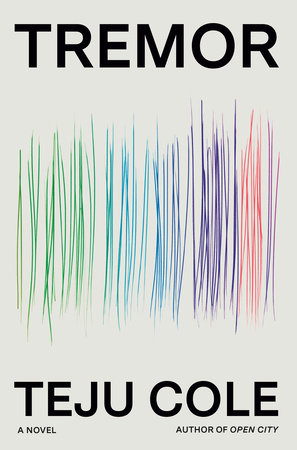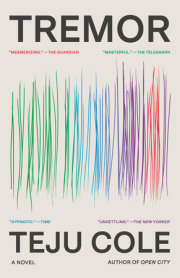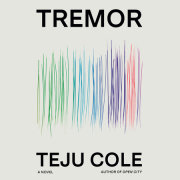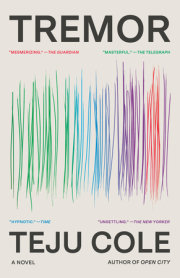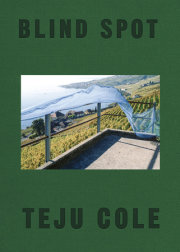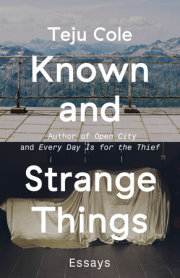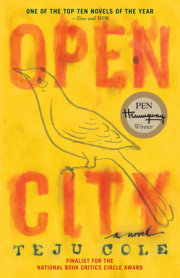The leaves are glossy and dark and From the dying blooms rises a fragrance that might be jasmine. He sets up the tripod and begins to focus the camera. He has pressed the shutter twice when an aggressive voice calls out from the house on the right. This isn’t the first time this kind of thing has happened to him but still he is startled. He takes on a friendly tone and says he is an artist, just photographing a hedge. You can’t do that here, the voice says, this is private property. The muscles of his back are tense. He folds the tripod, stows the camera in its bag, and walks away.
On Monday he goes to the department where packages and other mail await him, among them a white envelope with a quarter-inch-thick black line along its flap. Two or three envelopes of this kind arrive each month, official announcements of the passing of past or current members of the faculty. The envelope is almost square. He sits in his office and opens it. The card inside is also trimmed in black. An emeritus professor of microbiology, not someone he knows, has died. The cards don’t deviate from a formula: the dean expresses regret at the death of the professor in question in antiquated language. A death that “occurred on the sixth instant” is one that happened on the sixth of this month; “the fifteenth ultimo” is the fifteenth of last month. He has begun to collect the cards, thinking of them in their high-toned formality as an echo of the mourning dress worn in previous times, the silks and grenadines of widows’ gowns in the Civil War era, the black veils, black gloves, and black jewelry that let society know a grief was being observed. That symbolic order of colors is gone now, that tracking of heavy, full, or partial mourning in the language of black, gray, purple, lavender.
There are two books on his desk: Calvino’s Invisible Cities and a translation of the Epic of Sundiata. The latter contains versions of the epic by two different djeli, Bamba Suso and Banna Kanute, and he has recently finished reading Bamba Suso’s version. On one of the bookcases is a bottle of dark ink sent to him by Paul Lanier. The ink is made from wild grapes collected around railway tracks in St. Louis and because it is homemade, the color has shifted. In the bottle it still looks deep, close to violet, but brushed on paper it has now taken on a pale color reminiscent of the sea. But “the sea” how? When we say the sea is blue we are thinking of a light or pale blue, a color close to sky blue. The sea is sometimes one of those blues and sometimes a darker version of them but the sea is also often not blue at all: it is sometimes orange, sometimes gray, sometimes purple with the iridescence of Homer’s πορφύρεος, sometimes nothing, transparent, water. At dusk it goes from silvery to pewter. On a moonless night it is black.
He picks up the bottle of ink, an aged lavender, a purple haunted in its lower registers by indigo. The African violet is where the name comes from but he also loves the false web of etymologies the name summons: the tenderness of a viol, the strain of a violin, the hint of violence. Not the violet of medieval bishops and university professors but rather the violet of darkest African skin. Paintings by Mark Rothko, Agnes Martin, Lorna Simpson, but above all Chris Ofili in the lower register of whose Mary Magdalene is a violet so deep it could drown the eyes, in whose Raising of Lazarus there is a violet so base it could raise the dead. The hand-dyed, hand-spun cloth that he took from his grandmother’s wardrobe a few months after her death. Gray for loss, violet for love.
They go up to Maine to shop for antiques. The trip takes an hour and a half and during the brief crossing into New Hampshire they switch places and she drives. The plan is to do a small stretch of southern Maine up to Kennebunk, visiting several shops. They have set aside the entire afternoon. At a large emporium in York he looks at a nineteenth-century map of North America hand-drawn by a child. On the outskirts of Ogunquit are yard signs saying “Blue Lives Matter” which in town give way to rainbow flags. Finally they come to Wells where they find a large shop set in a building that might once have been a barn. The shop, on two levels, is crammed with furniture, paintings, glassware, and porcelain, many of them from the early or mid-nineteenth century and quite a few older. They wander separately. She looks at a maple colonial-style drop-front desk. He is surprised to find a section with an assortment of wooden masks and sculptures, three of them recognizably African, the others possibly Pacific, Asian, or Native American. He is immediately drawn to an elegant antelope headdress with a soaring pair of horns, a ci wara. It stands around four feet tall and appears to be old, its wood stained dark, the information on the label imprecise. The sinuous lines and open-work carving depict a female antelope with a baby antelope carved onto her back, the fawn a miniature of the mother, their main difference being that its horns are not as proportionally long. Ci wara, credited by Bambara people with having brought agriculture to humanity, is danced in its male and female forms as headdresses for young men during sowing and harvesting festivals.
The two men who run the antiques shop seem to be in their mid-to-late eighties and their banter has the feel of a long-practiced comedic act. They tell Tunde that they are brothers-in-law but frequently taken for brothers. One jokes about the other being too old, the other jokes about the other not being handsome enough to be related to him. Tunde asks the slightly younger-looking man about the ci wara but the man has little additional information beyond the notion that the sculpture “might be authentic.”
To himself Tunde wonders what authenticity would mean. That this particular ci wara has been danced in a Bambara agricultural festival? Or that whether or not it was dance it was not made for the tourist trade, that it was made by Bambara people for the use of Bambara people? Whatever its story it had found its way to the coast of New England. It was in a shop among the unrelated treasures white people had collected by fair means or foul from across the globe. In the West a love of the “authentic” means that art collectors prefer their African objects to be alienated so that only what has been extracted from its context becomes real. Better that the artist not be named, better that the artist be long dead. The dispossession of the object’s makers mystically confers monetary value to the object and the importance of the object is boosted by the story that can be told about its role in the history of modern European art.
He has seen, in the past, a female ci wara figure comparable to the one he is looking at now sold at auction for $400,000. Those zeros, he knows, have everything to do with the trail of magic words that the auction house brushed over the object: “collected in situ,” “acquired,” “exhibited.” The more extensive this account of ownership the greater the sums that can change hands between sellers and buyers. The ci wara he is looking at in Wells is priced at $250 which seems to settle the question of authenticity: the sculpture has no “provenance” and thus its value is minimal. He feels he ought to rescue it. He wants to bring it closer to home, closer to his own home where it can be seen by kinder eyes, by eyes that place authenticity elsewhere. Why should the labor of the contemporary artist who makes a ci wara to sell to visitors be less deserving of honor than that of the “traditional” artist who makes a ci wara to be danced at a harvest festival? But he doesn’t want to fool himself. Money is still changing hands.
Sadako has decided that she wants the maple desk. It is compact and likely to fit into the back of their rented SUV. At the last minute he has doubts about the ci wara but Sadako insists that they buy it. They go up to the front of the shop where the rafter above the sellers is covered with photographs, cartoons, and clippings from old ads. Behind the counter is a card signed by Laura Bush. This does not surprise him as the Bush family compound is only fifteen minutes away in Kennebunkport and this part of Maine is a venerated area for the genteel wing of the political right. On a wooden post near the counter, among the faded flyers and curling laminated notices, he sees a small photocopied note in all-caps, worn by time and undated:
wells homestead. this homestead was settled in 1657 by dr. thomas wells. in august of 1703 his grandson deacon thomas was away looking for a nurse for his wife sarah (browne) who had given birth the evening before to a daughter. while he was away the town of wells was attacked by indians. they struck at this farm first. axing their way into the house, they massacred mrs. wells, her infant, 4 year old sarah and 2 year old joshua. then they burned the house down. after this terrible tragedy mr. wells left for ipswich, massachusetts, returning sometime after 1718 with a new family to reclaim the homestead. it remained in the wells family until 1906.
Copyright © 2023 by Teju Cole. All rights reserved. No part of this excerpt may be reproduced or reprinted without permission in writing from the publisher.

